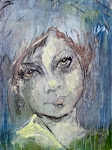
For example, I've been happy using Krylon's Crystal Clear for years as the most affordable and effective finishing spray for my work until I destroyed the luster on a piece that was primarily micaceous iron oxide and charcoal. I had to start over, and though I eventually got over the disappointment, for the first time I started questioning and thinking about why I was trying to 'varnish' mixed media work anyway.
When Rheni Tauchid's 2nd book, New Acrylics Essential Sourcebook came out, I thought about it even more after reading about mixed media and presentation in chapter 7 'Beyond the Basics'. It's a very good question for us artists that are exploring the outer limits of material combinations and yet it seems to me it may remain unsolved because there are too many variables and that maybe it's not about one golden answer...but rather knowing all your options.
I personally believe that if you are using quality materials, the discovery and collision of magic is all that matters. I have many beautiful pieces that are unvarnished and unframed because I've decided against it for one reason or another....but that said, I would love to know your thoughts about varnishing, finishing, fixing, protecting mixed media artwork that contains paint and drawing materials ie. charcoal on acrylics. Do you choose to varnish or not varnish? Any tips or product recommendations....
Here are some experimental and common sense methods that I know about, not including liquid 'brush-on' varnish such an acrylic polymer or top coat since I'm specifically interested in mixed media .
- frame the work behind glass
- use a matte or satin spray varnish, or Crystal Clear or Kamar Varnish. I used to use Grumbacher's Final Fixatif spray but it's now being sold as Prismacolor Tuffilm and is not as accessible to me. The downfall to all of the these products is they are permanent. I now recommend to spot varnish by masking off areas that are metallic, interference or glitter ect
- work the dry media into the paint or surface - this is a technique that creates a symbiotic superhero by combining materials while paint is still wet
- using a pastel fixative in between layers, leaving the last layer rich and soft (which is delicate, so I guess you should frame it!)
- using skim milk to fix charcoal and pastel on paper. Of course it will alter the work, so definitely an interesting approach for a particular effect (more on this technique here). ps. I am finding that I prefer wood panels and watercolour or printmaking paper to canvas these days.
- Sell your work in print format (cards, posters, giclee ect)
Rheni's blog - http://newacrylicsbooks.blogspot.com/
New Acrylics Essential Sourcebook can be purchased at Amazon -a great addition to your library for all acrylic and mixed media artists!




Hi Sharlena -
ReplyDeleteAs an art supplies retailer, I've had this conversation with artists literally hundreds of times, and heard equally as many horror stories involving varnish, mixed media, untested grounds, and - invariably - whispered expletives.
My own first unhappy experience occurred back in art school, with a mixture of graphite, rubber cement and hairspray. (Yes, some teachers are still recommending hairspray as a fixative.) Not coincidentally, that's when my fascination with chemistry also began. It turns out that even a small understanding of chemistry can be very helpful to the mixed-media artist.
I've also had a micaceous iron oxide episode, though my drawing medium was coloured pencil. In my haste to complete a piece for a show, I hadn't considered that the solvents in spray varnish (tolulene, naphthalene, acetone, xylene, assorted benzenes...) would dissolve the pencil's binder. It was also my first successful magic trick - "Watch the drawing disappear before your eyes." The nice M.I.O. background did remain sparkly, (Golden MSA spray varnish Satin) but the drawing had to be redone.
Drawing media can be likened to painting with sugar - the more liquid (fixative or varnish) you apply, the more the sugar dissolves, changing its colour, texture and ability to sit on top of the substrate. Layers of colour may begin to merge, and in the case of an absorbent or sanded surface, will "melt" and fill the crannies between peaks, obscuring the substrate (your lovely sparkly M.I.O.).
Some media behave quite nicely when given a quick coat of acrylic gel or medium. My favourite and most predictable combo is graphite with clear gesso. I like the messy smoky effect of charcoal + matte gel. And watercolour pencil/crayon with matte medium and/or dry media ground is gorgeous. All those combinations allow you to add as many layers as you wish.
For untreated dry media, framing behind glass is by far the most sensible solution, though we know it's not always feasible. Even frugal use of fixative can unpredictably discolour either your drawing our your substrate (be extra cautious with scratchboard).
Masking sensitive areas is an option, though my experience in varnishing metallics has always been positive. My suspicion regarding your disappearing sparkle leans more toward the 'varnish + pigment = pigment soup' scenario.
We know that the proper varnish/finish protects the surface of artwork. We also know that non-removable finishes can be damaged as easily - and as permanently - as the artwork itself. Additionally, Steve G will share with you some research that indicates so-called removable varnishes used on acrylics may in fact not be removable after a period of time. Varnishing is always going to be a personal decision, individual to each artist & artwork.
In the end, I believe it's safe to follow the rules:
1. Handle untreated dry media painting as you would a drawing on paper - frame behind glass.
2. When in doubt, do a short media test drive before you commit to varnish.
Happy painting!
-Donna